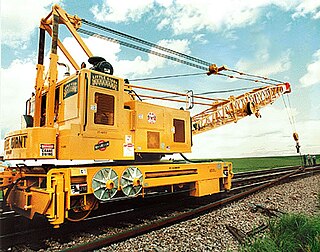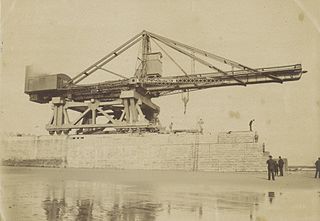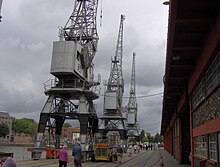
A crane is a type of machine, generally equipped with a hoist rope, wire ropes or chains, and sheaves, that can be used both to lift and lower materials and to move them horizontally. It is mainly used for lifting heavy objects and transporting them to other places. The device uses one or more simple machines to create mechanical advantage and thus move loads beyond the normal capability of a human. Cranes are commonly employed in transportation for the loading and unloading of freight, in construction for the movement of materials, and in manufacturing for the assembling of heavy equipment.

Under the Whyte notation for the classification of steam locomotives, 0-4-0 represents one of the simplest possible types, that with two axles and four coupled wheels, all of which are driven. The wheels on the earliest four-coupled locomotives were connected by a single gear wheel, but from 1825 the wheels were usually connected with coupling rods to form a single driven set.

A railroad crane is a type of crane used on a railroad for one of three primary purposes: freight handling in goods yards, permanent way (PW) maintenance, and accident recovery work. Although the design differs according to the type of work, the basic configuration is similar in all cases: a rotating crane body is mounted on a sturdy chassis fitted with flanged wheels. The body supports the jib and provides all the lifting and operating mechanisms; on larger cranes, an operator's cabin is usually provided. The chassis is fitted with buffing (UK) and/or coupling gear to allow the crane to be moved by a locomotive, although many are also self-propelled to allow limited movement about a work site.

An armoured recovery vehicle (ARV) is typically a powerful tank or armoured personnel carrier (APC) chassis modified for use during combat for military vehicle recovery (towing) or repair of battle-damaged, stuck, and/or inoperable armoured fighting vehicles, such as tanks and armoured personnel carriers. Most ARVs have motorized tracks, like a tank or bulldozer, enabling the ARV to operate on uneven ground. The term "Armoured Repair and Recovery Vehicle" (ARRV) is also used.

Rothwell, Hick and Rothwell was an engineering company in Bolton, England. Set up in 1822, the partners became interested in the production of steam locomotives after the Rainhill Trials. The company's first engine was Union, a vertical boiler, 2-2-0 with horizontal cylinders for the Bolton and Leigh Railway of which Hick and Rothwell were promoters and original shareholders, followed by three more locomotives the following year for American railways.

The Avonside Engine Company was a locomotive manufacturer in Avon Street, St. Philip's, Bristol, England between 1864 and 1934. However the business originated with an earlier enterprise Henry Stothert and Company.

A steam crane is a crane powered by a steam engine. It may be fixed or mobile and, if mobile, it may run on rail tracks, caterpillar tracks, road wheels, or be mounted on a barge. It usually has a vertical boiler placed at the back so that the weight of the boiler counterbalances the weight of the jib and load.

Titan Clydebank, more commonly known as the Titan Crane is a 150-foot-high (46 m) cantilever crane at Clydebank, West Dunbartonshire, Scotland. It was designed to be used in the lifting of heavy equipment, such as engines and boilers, during the fitting-out of battleships and ocean liners at the John Brown & Company shipyard. It was also the world's first electrically powered cantilever crane, and the largest crane of its type at the time of its completion.

The Douglas Breakwater Crane Railway was a massive self-propelled steam block-setting crane, with a capacity of 15 tons, built by Stothert & Pitt of Bath that ran the length of the original breakwater at Douglas, also used for the loading and unloading of vessels.

Clarke Chapman is a British engineering firm based in Gateshead, which was formerly listed on the London Stock Exchange.

A Fairbairn crane is a type of crane of an 'improved design', patented in 1850 by Sir William Fairbairn. There are numerous hand-powered versions around the world and one surviving steam-powered example in Bristol Docks, England.

A bulk-handlingcrane is one that, instead of a simple hook that can handle a range of slung loads, has an integral grab for lifting bulk cargoes such as coal, mineral ore etc.

Westmoreland Road goods yard was the main Great Western Railway goods station for the city of Bath in England, situated on the main line between the passenger stations of Oldfield Park and Bath.

Thomas Smith & Sons manufactured steam, diesel and electric powered cranes in their Old Foundry on a narrow strip of land between Town Street in Rodley near Leeds and the Leeds and Liverpool Canal.
Joseph Booth & Bros was an English company notable for making cranes used in large construction projects.

A block-setting crane is a form of crane. They were used for installing the large stone blocks used to build breakwaters, moles and stone piers.

A Hercules crane was a form of block-setting crane, developed in the 1870s. They were characterised by a wheeled, mobile gantry running on rails, surmounted by a slewing horizontal jib, held up by a kingpost.

The Pedrail Machine was an experimental British armoured fighting vehicle of the First World War. It was intended initially to be used as an armoured personnel carrier on the Western Front, but the idea was dropped in favour of other projects. Work on the machine was re-directed so that it could be used as the basis of a mobile flamethrower, but it was never completed and saw no action.

The Arrol Gantry was a large steel structure built by Sir William Arrol & Co. at the Harland and Wolff shipyard in Belfast, Northern Ireland. It was built to act as overhead cranes for the building of the three Olympic-class liners.






















